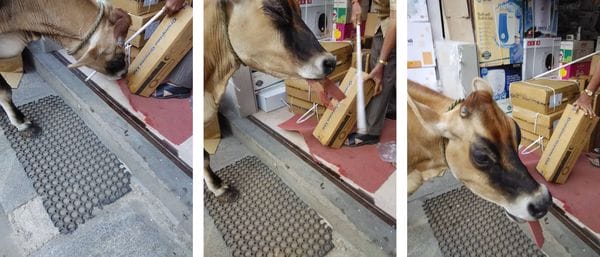
Pic: Bharath Rajshekhar
I have been told time and again that the cow is holy, and I have believed it until I was witness to this… a shocker, the most disturbing incident.
I had been to Chickpet to buy some electrical appliances and was sitting in the shop waiting for my things to be packed. Suddenly, a big cow appeared in front of the shop. The emptiness in its eyes gave me the impression that its stomach might be empty too.
I proposed to the shopkeeper that we offer her something to eat, maybe some bananas. I was taken aback when he told me this cow was a regular visitor, who never ate bananas. For a while, I assumed he had gone bananas. He then told a staff member to get a loaf of bread.
Before the bread could arrive, something grave happened. Our holiness, our sacred cow, started ripping and tearing off the plastic footmat which was at the entrance of the shop, and settled down to chew it. The shopkeeper and I tried to snatch away the plastic from its mouth, but in vain. We could not, as it appeared to be its favourite food. It left once it had relished the plastic and its hunger was sated.
We proudly believe and follow that the holy cow, ‘gomaatha’, should not be slaughtered. What a pity, considering that we don’t really mean it. If we did, we would not be throwing garbage on the roads, neatly packed in knotted plastic bags, making it all the more difficult for our cows to unknot and eat the waste. We are in a way, forcing them to eat the entire plastic bundle, and thereby slowly accumulate a huge pile of plastic in their stomachs.
When I read further on this topic, I found out that animals that eat plastic all their lives, start feeling averse towards their natural food and die a painful death. So ultimately, this holy cow is slaughtered by the plastic thrown by us.
So my dear friends, let us all say no to plastic wherever we can. Let us carry our own cloth bags while shopping. Let us stop throwing our kitchen waste in plastic covers. Let us convert insted convert the waste into compost, feed this to our plants, and in turn, feed these greens to our holy cow.
If we don’t, then we should be ready to call our holy cow, poly cow…
Editor’s note: Here’s some additional food for thought in the form of a documentary called Plastic Cow.
The documentary commisioned by Karuna Society for Animals and Nature, uncovers the impact of plastic waste on the cows in India, which have been reduced to being scavengers, especially in urban areas.